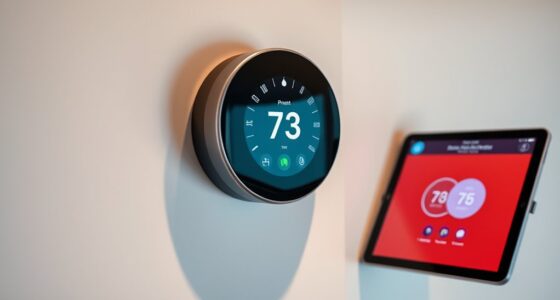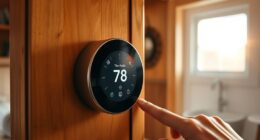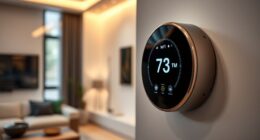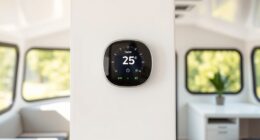When deciding on smart thermostats for your multi-family building, consider energy savings, tenant comfort, and compliance with local regulations. Make sure the devices are compatible with your HVAC systems and factor in installation costs, especially for retrofits. Pay attention to data security, privacy policies, and ongoing maintenance needs. Properly selecting and installing the right smart thermostats can enhance efficiency and satisfaction—continue exploring to learn more about making best choices for your building.
Key Takeaways
- Assess compatibility of existing HVAC systems with smart thermostats to ensure proper installation and functionality.
- Review local zoning regulations and obtain necessary permits to ensure compliance before installation.
- Consider tenant needs and preferences for customized control and remote access features.
- Factor in upfront costs, ongoing maintenance, and potential energy savings for a cost-effective solution.
- Prioritize data security and establish clear policies to protect tenant privacy and meet legal requirements.
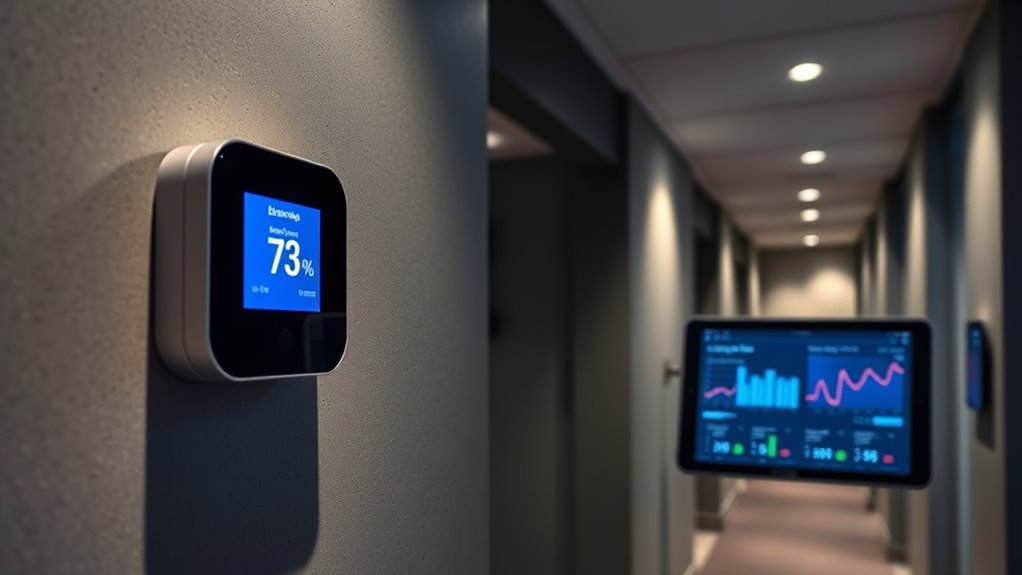
Smart thermostats are revolutionizing energy management in multi-family buildings by providing tenants and property managers with greater control and efficiency. These devices not only allow for customized temperature settings but also enable remote adjustments, leading to improved occupant comfort and energy savings. However, before deciding to install smart thermostats, you need to consider how zoning regulations might impact your plans. Many municipalities have specific rules regarding energy systems, especially in multi-unit complexes. You may need permits or approvals to modify existing HVAC controls or install new smart devices. Ensuring compliance with local laws can prevent costly delays or fines, so it’s wise to review zoning codes beforehand. Additionally, some regulations may restrict certain types of smart technology or require specific safety standards, which could influence your choice of thermostats.
Consider zoning regulations before installing smart thermostats to ensure compliance and avoid delays or fines.
When evaluating smart thermostats, you should also think about maintenance costs. Although these devices are designed to be low-maintenance, they do require periodic updates and troubleshooting. Unlike traditional thermostats, smart units often connect to Wi-Fi and rely on software that may need regular updates to stay secure and functional. If something goes wrong, you might need specialized support, which can add to your ongoing expenses. furthermore, installing smart thermostats across multiple units can involve upfront costs for hardware, professional installation, and integration with existing HVAC systems. While these investments are often offset by energy savings over time, it’s essential to account for potential maintenance and repair costs in your budget.
Another critical aspect is the compatibility of smart thermostats with your building’s existing infrastructure. Not all HVAC systems are ready for smart control, and retrofitting older systems might require additional equipment or upgrades. This can increase initial costs and complexity. Also, consider the tenant experience—smart thermostats can empower residents to manage their comfort, but you need clear policies and instructions to prevent misuse or confusion. Educating tenants about the benefits and proper operation can maximize energy efficiency and reduce calls for maintenance.
Finally, think about data security and privacy. Smart thermostats collect usage data, and safeguarding this information is essential. You’ll want to choose devices with strong security features to protect tenant privacy and comply with relevant data protection regulations. By carefully weighing zoning regulations, maintenance costs, compatibility issues, and security concerns, you can make an informed decision that enhances your building’s energy management while minimizing legal and financial risks.
Frequently Asked Questions
How Do Smart Thermostats Impact Tenants’ Comfort Preferences?
Smart thermostats boost tenant satisfaction by allowing personalized comfort settings, so each resident can adjust the temperature to their preferences. You can offer customization options, ensuring everyone feels comfortable and satisfied. This flexibility helps improve overall tenant experience, reduces complaints, and promotes energy efficiency. When tenants control their environment, they’re more likely to stay happy, making smart thermostats a valuable addition for multi-family buildings.
What Are the Costs Associated With Installing Smart Thermostats?
Installing smart thermostats involves costs like device purchase, professional installation, and potential wiring upgrades, which can pose installation challenges. However, you can offset these expenses with cost-saving strategies such as bulk purchasing, leveraging rebates, or energy efficiency incentives. While upfront costs may seem high, smart thermostats typically reduce energy bills over time, making them a worthwhile investment for improving tenant comfort and building efficiency.
Are There Security Concerns With Shared Smart Thermostat Systems?
Security scares surface with shared smart thermostat systems, sparking privacy concerns and hacking vulnerabilities. You might worry about data breaches or unauthorized access, which could compromise tenant privacy or cause control chaos. To combat these concerns, guarantee robust passwords, encryption, and regular updates. By prioritizing protection, you can prevent potential pitfalls, providing peace of mind while enjoying the benefits of smart technology. Remember, proactive precautions keep your building secure and tenants safe.
How Do Smart Thermostats Integrate With Existing Building Management Systems?
Smart thermostats seamlessly integrate with your existing building management systems by connecting through standard protocols like BACnet or Modbus, ensuring compliance with building codes. They enhance energy efficiency by allowing centralized control and real-time adjustments. You can set schedules, monitor usage, and optimize heating or cooling, all while maintaining security standards. This integration simplifies management and helps you meet energy regulations effectively.
What Maintenance Is Required for Smart Thermostats in Multi-Family Buildings?
Smart thermostats require minimal maintenance, with studies showing they save up to 23% on energy costs. You’ll need to check for firmware updates regularly to guarantee peak performance and security. Also, if your thermostats run on batteries, plan for periodic replacements, usually once a year. Keeping these up-to-date guarantees your devices function smoothly, helping you manage your building’s climate efficiently and reliably.
Conclusion
Installing smart thermostats can cut energy costs by up to 30%, making them a smart choice for multi-family buildings. Not only do they boost comfort for residents, but they also help you save money and reduce environmental impact. With nearly 70% of tenants preferring smart technology, upgrading now means happier tenants and lower bills. Embrace smart thermostats today to create a more efficient, comfortable, and future-proof building.


